Orange annual flowers add happy warmth to gardens and containers, symbolizing joy, excitement, and passion. Orange is a vivid hue to add to any plant grouping! Enjoy our list of 10 orange annual flowers to add a touch of warming glow to the pots and garden beds you tend.
Whether in the hues of apricot or carrot, orange garden flowers attract many birds, butterflies, and bees. Depending on where you live, your orange flowers might appeal to warblers, hummingbirds, and orioles. So, if you’re hoping to bird-watch and please the pollinators, planting orange annual flowers is a great step toward those goals!
Chrysanthemum
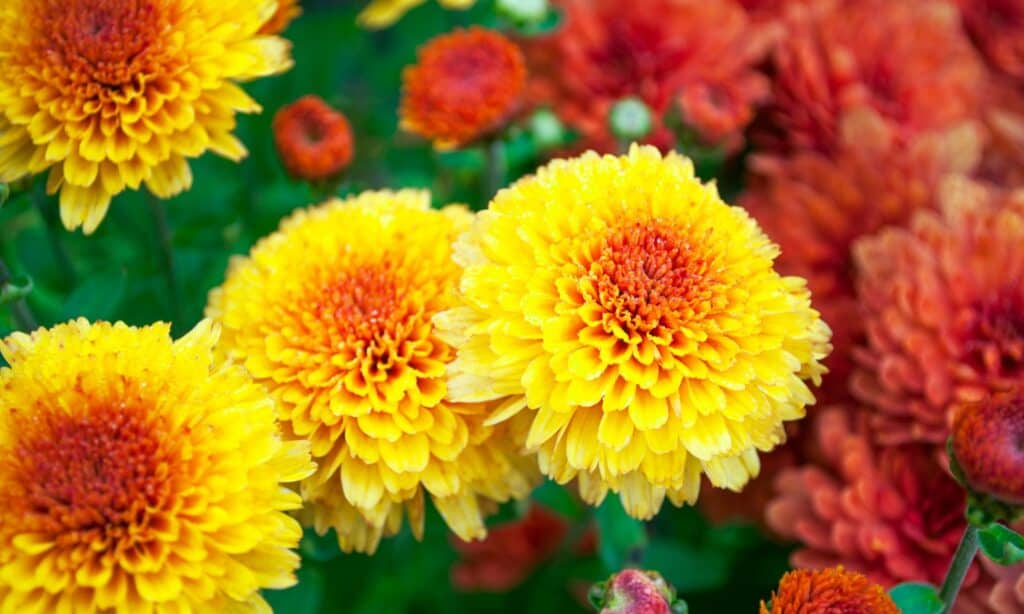
Orange hybrid chrysanthemums come in multiple varieties, including Avalon Orange, Fancy Orange, and Orange Zest.
©Elan Havrilyuk/Shutterstock.com
Botanical name: Chrysanthemum x morifolum
Common names: mum, garden mum, florist’s daisy
USDA hardiness zones: 6 to 11
Sun exposure: full sun preferred
Mature size: up to 24 inches tall, 36 inches wide
Bloom time: summer to fall
Flower colors: orange, yellow, green, white, purple, pink
Growing chrysanthemums or “mums” in garden beds and containers is relatively easy. And their fall-colored blooms make excellent porch decor in autumn! Because they bloom in fall, mums are perfect flowers to plant in September. Orange hybrid chrysanthemums come in multiple varieties, including Avalon Orange, Fancy Orange, and Orange Zest.
Chrysanthemum blooms and petals vary widely in appearance, but they are generally large and showy. The petals may be smooth or ruffled, form a round fluffy bloom, and often have a strong fragrance.
Mums are perennials in warmer climates and grow beautifully as annuals in colder zones from late summer through mid-fall.
Orange mums perform best in full sun, although they will tolerate light shade. And they prefer well-drained soil covered with compost.
Chrysanthemums should be watered regularly, especially during hot, dry weather. However, don’t give them too much water! Unfortunately, root rot occurs when mums sit too long in wet soil. Plus, powdery mildew – a fungal disease that presents as white spots – is often a sign of mums sitting too long in humid weather.
Fertilize every other week to keep mums healthy. Deadhead (cut off) spent flowers to encourage continued blooming and shape plants as needed to control their size and overall look.
Mums are somewhat pest free, though they’re sometimes a favorite snack of aphids, beetles, and caterpillars.
Dahlia
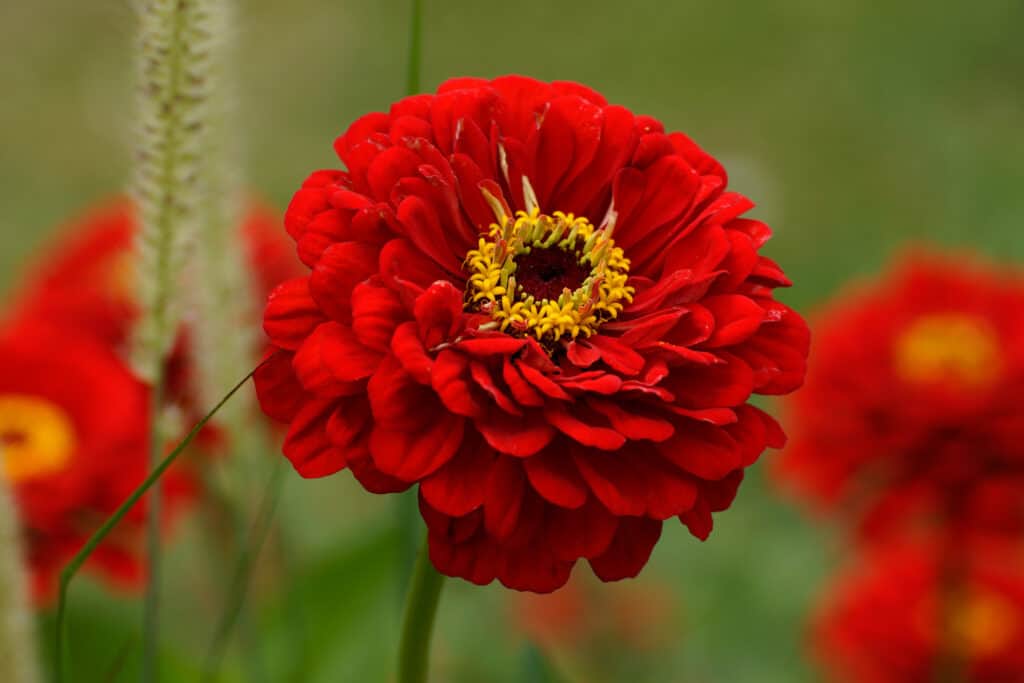
The Dahlia is the national flower of Mexico.
©iStock.com/Helena Bezold
Botanical name: Dahlia pinnata
Common names: dahlia, garden dahlia
USDA hardiness zones: 8 to 11
Sun exposure: full sun preferred
Mature size: 1-3 feet tall and wide, depending on the variety
Bloom time: summer through fall
Flower colors: orange, yellow, white, pink, red, purple
Dahlias are perennials often planted as annuals. They grow from small tubers and produce showy flower heads on hollow stems. Depending on the variety, dahlia flower heads can be 8 inches in diameter or more.
Orange dahlias grow best in full sun and well-draining soil. Therefore, they need regular watering, especially during hot weather. In addition, your orange dahlias need to be fertilized monthly with a low-nitrogen fertilizer. And to encourage continued blooming, consistent deadheading of spent dahlia flowers is essential.
Be aware that dahlias attract some garden pests. Watch for aphids, slugs, snails, spider mites, whiteflies, and mealybugs. Also, watch for common dahlia diseases like powdery mildew, root rot, and gray mold. All of these conditions could be caused by overwatering or humid weather.
Cosmos
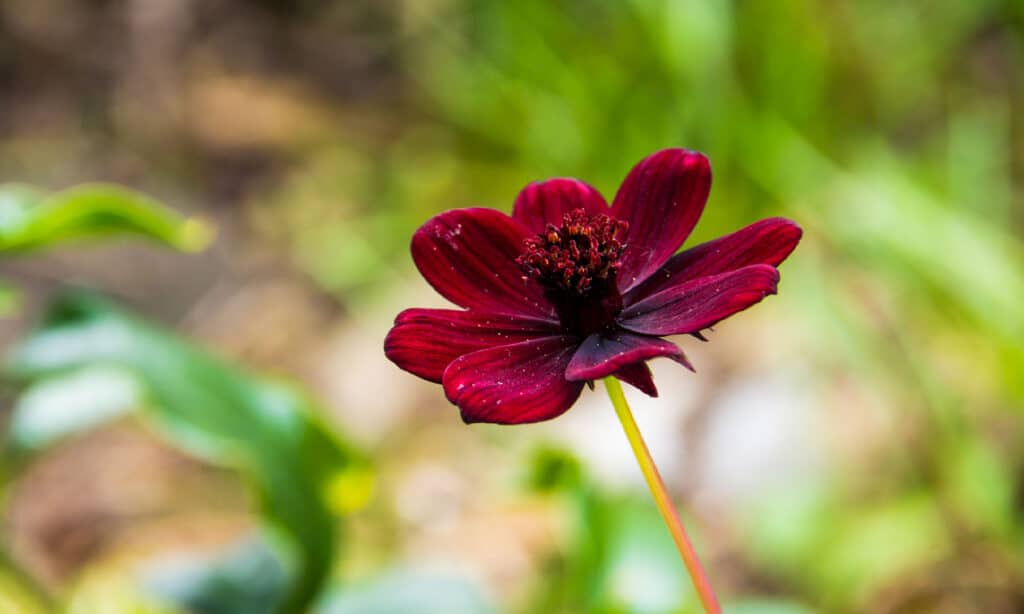
Cosmos sulphureus will self-seed, so pinch off the spent flowers if you don’t want these hardy plants to spread.
©iStock.com/kinpouge05
Botanical name: Cosmos sulphureus
Common names: cosmos, sulfur cosmos, Mexican aster
USDA hardiness zones: 2 to 11
Sun exposure: full sun preferred
Mature size: up to 2 feet tall, 2 feet wide
Bloom time: summer through fall
Flower colors: orange, yellow, pink, red, white, maroon
Cosmos is a popular annual that is easy to grow from seed and produces bright orange flowers on tall, upright stems. Cosmos sulphureus will self-seed, so pinch off the spent flowers if you don’t want these hardy plants to spread. These lovely orange annual flowers add warmth to cottage gardens, cutting gardens, and traditional garden beds. And they’ll attract butterflies and hummingbirds, too!
Orange cosmos flowers grow beautifully in full sun and moist but well-drained soil. Luckily, these orange flowers are drought tolerant, so if you miss a watering or two, they should be fine. However, cosmos flowers perform better with regular watering, especially on hot summer days.
Fertilize your cosmos plants every 3-4 weeks to keep them healthy. Deadhead the dead blooms if you want them to bloom again during the growing season.
Cosmos flowers can fall victim to aphids, thrips, slugs, and the occasional bunny looking for a treat. Diseases common to cosmos garden flowers include blight, grey mold, and powdery mildew.
African Marigold

Marigolds love to be in full sun and moist, loamy soil that drains well.
©Andrei Dubadzel/Shutterstock.com
Botanical name: Tagetes erecta
Common names: marigold, African marigold, Aztec marigold
USDA hardiness zones: 2 to 11
Sun exposure: full sun preferred
Mature size: up to 4 feet tall, 2 feet wide, depending on the variety
Bloom time: summer through fall
Flower colors: orange, yellow, red
African marigold plants have big, double flowers in light or dark orange, with bushy foliage. And these low-maintenance orange flowers bring a lovely fragrance to the garden! This marigold’s appealing smell is due to the entire plant – from blooms to leaves — having a pleasing spicy scent.
Marigolds love to be in full sun and moist, loamy soil that drains well. Therefore, keep their soil moist and deadhead regularly for additional blooms.
Common leaf spots might develop on African marigolds due to soil with low pH. A lime treatment might be necessary to help with pH balance unless leaf spots are caused by bacteria instead.
African marigolds are deer resistant but might attract a few pests like thrips and spider mites.
These bright, mood-lifting flowers grow well in garden borders and containers with full sun exposure.
Gerbera Daisy

As with most garden flowers – no matter their color – gerbera daisies perform better in well-drained soil.
©fon.tepsoda/Shutterstock.com
Botanical name: Gerbera jamesonii
Common names: gerbera daisy, gerber daisy, Transvaal daisy, Barberton daisy
USDA hardiness zones: 8 to 11
Sun exposure: full sun to partial sun
Mature size: up to 18 or 24 inches tall and wide
Bloom time: spring through fall
Flower colors: orange, yellow, salmon, pink, red, lavender, bi-color
Orange gerbera daisies are both sturdy and elegant flowers in the garden. Their large rosette blooms on tall stems come in various colors, but the orange blossoms are particularly showy. Their long-petaled blooms resemble that of daisies (hence their name) and grow up to 4-inches or so around.
As with most garden flowers – no matter their color – gerbera daisies perform better in well-drained soil. In addition, they grow best in full sun to partial shade, and they’re usually tolerant of drought conditions. That said, it’s important to regularly water these orange annual flowers when the top inch or so of their soil feels dry. And if your gerbera daisies wilt, you probably overwatered them.
Other conditions to watch for with these orange annual flowers are root rot (again from overwatering), leaf spot, and powdery mildew. Additionally, you might catch some tiny critters munching on gerbera daisies like aphids and whiteflies.
Orange gerbera daisies are the perfect choice for a colorful cut flower garden. Plus, these cheery blooms will dazzle in flower arrangements.
Jungle Geranium
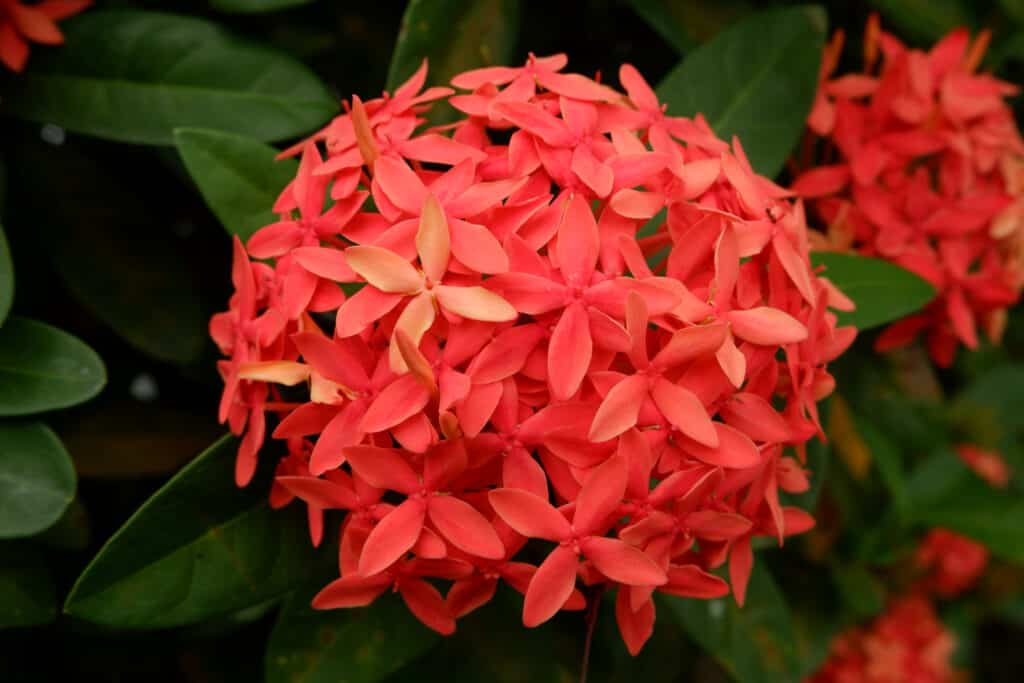
Their love of tropical weather is why jungle geraniums grow exceptionally well in Florida.
©Aldrin Rachman Pradana/Shutterstock.com
Botanical name: Ixora coccinea
Common names: flame of the woods, jungle flame, firey love, jungle geranium
USDA hardiness zones: 9 to 11
Sun exposure: full sun to partial shade
Mature size: from 3-6 feet tall and wide
Bloom time: spring through fall
Flower colors: orange, red, yellow
Jungle geraniums are shrubs with cluster flowers full of small 4-petal blooms. In addition to their beauty, they can grow up to 6 feet or even 12 feet tall! However, these plants won’t usually grow that tall unless planted in more tropical environments. Their love of tropical weather is why jungle geraniums grow exceptionally well in Florida.
Warmer growing zones give this showy shrub a longer life as a perennial. However, jungle geraniums grow well as annuals in other zones.
If not for their cluster flower beauty, consider planting jungle geraniums for the love of butterflies. These annual flowers are strong butterfly magnets, attracting multiple species.
Orange jungle geraniums require lots of growing space in full sun to partial shade. So keep the soil moist and well-drained. And to keep them extra-bushy, re-fertilize geraniums every couple of weeks in spring through fall.
The geranium budworm and sawfly are two pests that might harm these shrubs. As for common diseases, jungle geraniums might suffer from different types of blight (leaf and flower), root rot, and crown rot.
Jungle geraniums grown as annuals do well in containers or garden beds but give these fluffy plants plenty of room to grow.
Pansy

Like the African marigold, orange pansies are fragrant annual flowers.
©Leecy Jones/Shutterstock.com
Botanical name: Viola x wittrockiana
Common names: pansy, garden pansy
USDA hardiness zones: 6 to 10
Sun exposure: full sun to partial shade
Mature size: up to 10 inches tall, 1 foot wide
Bloom time: spring through late fall or early winter
Flower colors: orange, yellow, red, blue, purple, pink, white, black
Like the African marigold, orange pansies are fragrant annual flowers. Pansies look very delicate, but they’re hardy plants that tolerate colder weather than many other annual flowers can handle. In addition, the pansy blooms for up to 6 months!
A pansy’s petals are usually two-toned and have a ruffled appearance. And you’ll want to pinch off the spent flowers to promote additional blooms.
Plant orange pansies in moist soil with excellent drainage. Pansies need full sun to partial shade in beds, pots, and window boxes. In addition, fertilize pansies once or twice a month with a phosphorus fertilizer to support healthy, abundant blooms.
Pansies are deer resistant, but aphids, caterpillars, slugs, snails, and other garden pests love eating them. Additionally, pansies are prone to an infection called black root rot that quickly kills off these plants. And once the pansy’s roots are mushy, it’s probably too late to save it.
To prevent pansy black root rot, check your soil’s pH balance to ensure it’s not too high. The fungi that cause black root rot (called Thielaviopsis) prefer soil with a pH of 6.2 and above.
Purslane
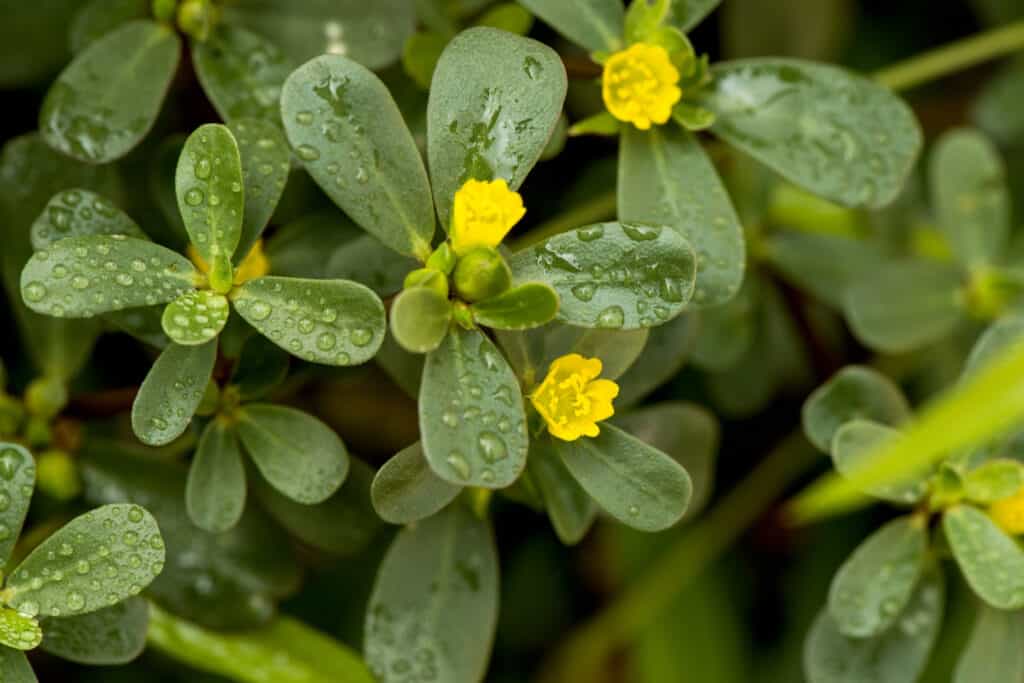
Purslane petals are shaped like stars and can be orange, yellow, or white.
©wasanajai/Shutterstock.com
Botanical name: Portulaca oleracea
Common names: purslane, garden purslane, little hogweed, wild portulaca
USDA hardiness zones: 2 to 12
Sun exposure: full sun preferred
Mature size: up to 3 feet tall, 2 feet wide
Bloom time: late spring through fall
Flower colors: orange, yellow, white
Orange purslane is an annual herb with trailing stems, fleshy leaves, and bright little blooms. The purslane plant is edible and used in herbal remedies. So, planting orange purslane in your garden provides beauty plus herbal benefits!
Purslane petals are shaped like stars and can be orange, yellow, or white. You’ll sometimes see all three colors on the same plant. The blooms are about 1/2 inch wide and open in the morning, closing up at night or during cloudy weather.
This easy-to-grow plant prefers full sun but will tolerate some shade. In addition, it’s drought tolerant, so it’s a good choice for xeriscaping, which means growing with little or no irrigation.
Plant purslane in well-drained soil and keep it moist. And the purslane is so easy to grow that you may only need to fertilize it once when you plant it.
Purslane is edible. The leaves are vitamin-rich and work well in soups and salads. However, ensure you’re using purslane in recipes and not a similar-looking plant called spurge. Do not eat any part of a spurge plant because spurge is toxic to humans and animals. One way to tell the difference between edible purslane and poisonous spurge is to cut one of the plant’s stems open while wearing gloves. If the stem leaks a milky substance, it’s probably spurge, and that substance could irritate your skin.
Because purslane is delicious and full of vitamins, this plant is a prime target for foraging animals and garden pests. But if you raise chickens, enjoy sharing your garden purslane with the flock. They’ll love it and benefit from purslane nutrients too!
Strawflower
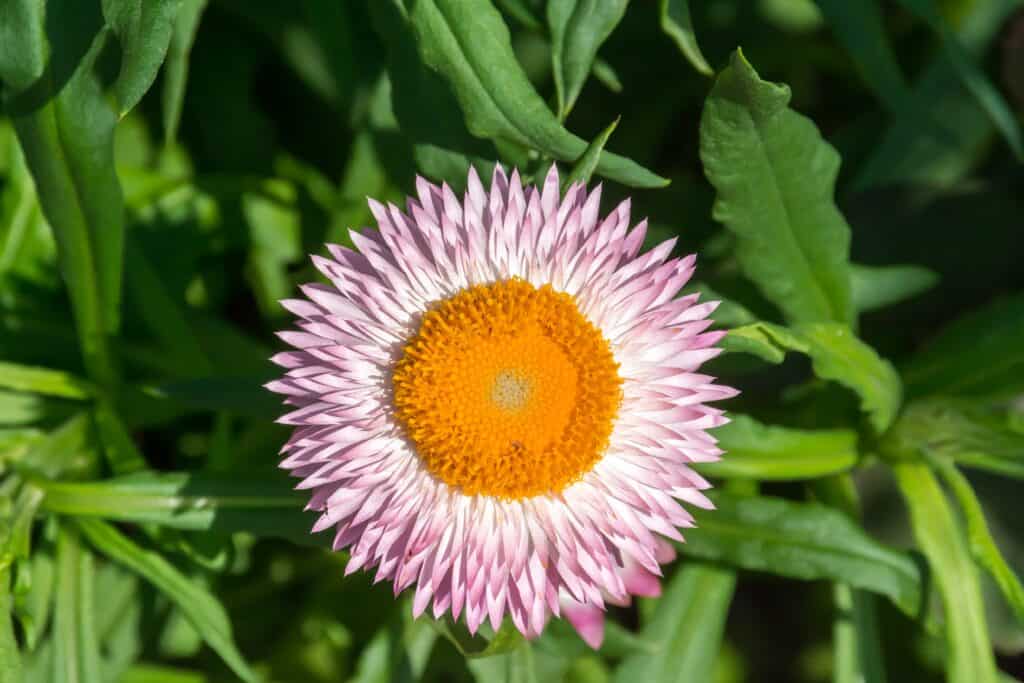
Orange strawflowers have daisy-shaped round flower heads with yellow centers.
©Reallyice/Shutterstock.com
Botanical name: Helichrysum bracteatum
Common names: strawflower, everlasting flower, paper daisy,
USDA hardiness zones: 8 to 11
Sun exposure: full sun preferred
Mature size: up to 5 feet tall, 2 feet wide
Bloom time: summer through fall
Flower colors: orange, yellow, pink, red, white
Strawflowers are unique annual herbs with blooms that feel like straw or stiff paper. Orange strawflowers add firey warmth to fresh flower arrangements and dried flower bouquets. They’re ideal for their long-lasting color in garden beds and containers.
Orange strawflowers have daisy-shaped round flower heads with yellow centers. Plus, they bloom on tall stems that grow up to 5 feet!
Strawflowers are heat-loving plants. So, they need full sun, with well-drained soil kept moist but not soggy. And they flower more often with consistent deadheading.
Fortunately, not many pests are attracted to strawflowers, but these plants might develop root rot or downy mildew. Strawflowers might also develop a condition called aster yellows caused by a pathogen found in the blood vessels of leafhoppers. A leafhopper is a tiny hopping insect that eats plant sap.
Did you know that strawflowers are also widely respected for their essential oil? It’s true! Strawflower essential oil is often used as a massage oil to ease muscle pain or regenerate skin cells.
Texas Lantana

The Texas lantana has little tube-shaped petals that create its round flower cluster.
©Cathleen Wake Gorbatenko/Shutterstock.com
Botanical name: Lantana urticoides
Common names: Texas lantana, trailing lantana, calico bush
USDA hardiness zones: 8 to 11
Sun exposure: full sun preferred
Mature size: up to 3 feet tall, 6 feet wide
Bloom time: late spring through fall
Flower colors: yellow, orange, pink, red, bi-color
Texas lantana is another attractive flowering shrub with brightly-colored clusters of blooms. And this shrub is extra special because its flowers change colors as they mature; first yellow, then orange, and finally red. In addition, the Texas lantana has little tube-shaped petals that create its round flower cluster.
This orange annual flower thrives in coastal gardens because it has no trouble growing in soil mixed with sea salt. In addition, the Texas lantana is deer and drought-resistant.
Grow this annual flower in full sun and keep its well-drained soil moist. Also, consider deadheading the spent flowers for two reasons. First, cutting away the spent flowers will encourage more blooms. Finally, getting rid of spent blooms means they won’t turn into berries. Because though this plant’s berries are beloved by the birds, they are toxic to humans, pets, and other animals.
Always wear your garden gloves when handling Texas lantana because of the plant’s toxins. In addition, don’t inhale or ingest any part of the plant, including its berries.
Because of this annual flower’s toxins, it isn’t a plant that garden pests usually munch on. However, this beauty of a shrub sometimes develops blight or gray mold.
Plant orange annual flowers for joyful garden color!
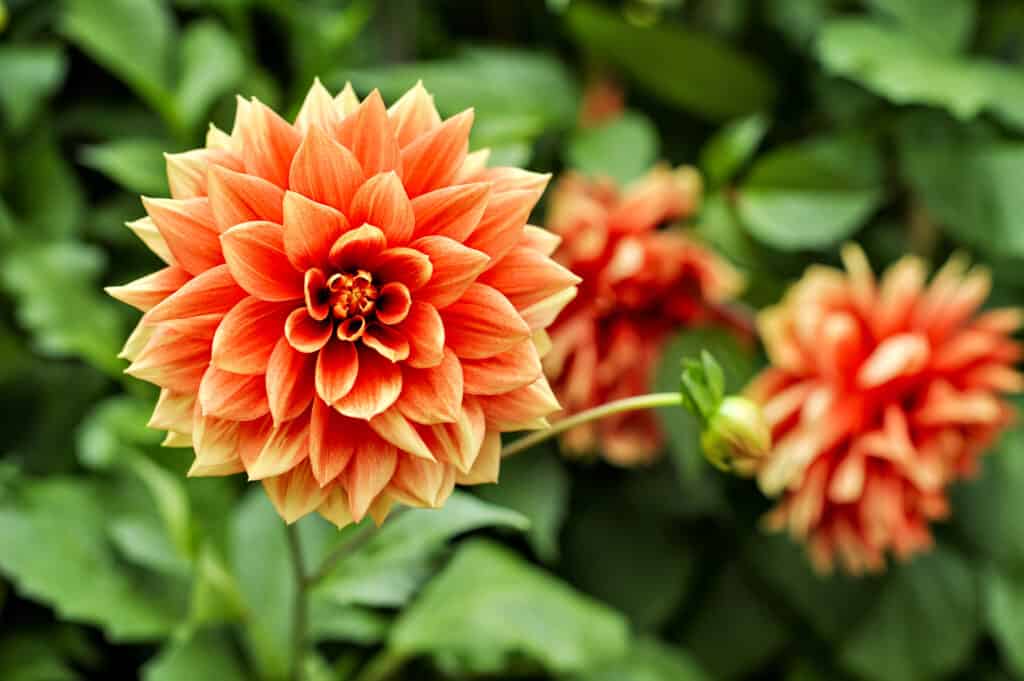
Be aware that dahlias attract some garden pests.
©LCRP/Shutterstock.com
Orange annual flowers bring bright and joyful warmth to any garden color scheme. And they come in many different shades, sizes, and bloom varieties! With so many orange flowers to choose from, we hope our list of 10 orange annual flowers helps you make the right choice for your garden. For example, will you choose orange flowering shrubs like jungle geranium or Texas lantana? Or do you prefer growing a cut flower garden full of orange gerbera daisies and cosmos? Whichever annual flowers you select, your orange blooms are sure to bring lots of birds and butterflies to your yard!
Up Next:
The photo featured at the top of this post is © Andrei Dubadzel/Shutterstock.com
Sources
- Proven Winners, Available here: https://www.provenwinners.com/learn/top-ten-lists/15-orange-flowers-your-garden
- National Gardening Association, Available here: https://garden.org/plants/view/82812/Texas-Lantana-Lantana-horrida/
- Clemson Cooperative Extension, Available here: https://hgic.clemson.edu/factsheet/gerbera-daisy/
Thank you for reading! Have some feedback for us? Contact the AZ Animals editorial team.






